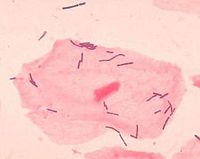Lactobacillus plantarum
For the course duration, the article is closed to outside editing. Of course you can always leave comments on the discussion page. The anticipated date of course completion is May 21, 2009. One month after that date at the latest, this notice shall be removed. Besides, many other Citizendium articles welcome your collaboration! |
 | ||||||||||||||
| Scientific classification | ||||||||||||||
| ||||||||||||||
| Binomial name | ||||||||||||||
Lactobacillus plantarum is a gram-positive, bacteria which ferments plants and is used industrially to make yogurt, cheese, and pickled vegetables. Apart from plants, L. plantarum is found in the human GI tract and acts as a probiotic bacteria. Its ability to survive in the GI tract has made this bacteria a target for further research in using it as a vehicle to deliver recombinant vaccines and treatments for diseases.
Genome structure
In 2003, Michiel Kleerebezem mapped out the complete genome of Lactobacillus plantarum WCFS1. Lactobacillus plantarum strain WCFS1 is known to have 3,308,274 base pairs and contains 3,052 protein-encoding genes as well as three plasmids (1,917-bp, 2,365-bp, and 36,069-bp,) which accounts for its high adaptability. The G+C content of the chromosome is 44.5%, but the plasmids contain slightly less G+C content. 4
Cell structure and metabolism
Lactobacillus plantarum is a gram positive, rod-shaped, organotrophic, aerotolerant, bacteria often called lactic acid bacteria because it gets most of its energy from converting glucose to lactate via homolactic and heterolactic fermentation. Homolactic fermentation uses the EMP pathway and heterolactic fermentation uses the phosphoketolase pathway. Therefore, L. plantarum is a facultative heterofermentative lactobacilli. 5 4
Ecology
Lactobacillus plantarum is a highly adaptive bacteria that can survive at temperatures between 1º to 60º Celsius and also a great range of atmospheric pressures. The name "plantarum" indicates that this bacteria is a "species of the plants." L. plantarum is found particularly in fermented plants, such as kimchee. However, it is also found in other fermented foods such as yogurt and cheese and it is also found in animal GI tracts, human saliva and vagina. [1] 3 4
Pathology
Lactobacillus plantarum 299v is actually considered to be a probiotic. Due to its ability to survive in the human GI tract for >6 days, L. plantarum 299v can inhibit the growth of other harmful bacteria such as E. coli in the host after contaminated meat consumption. L. plantarum 299v is found in various fermented foods such as yogurt, cheese, kimchee, and is recommended to be consumed regularly to support the immune system. In addition, the ability of L. plantarum 299v to produce lactic acid helps maintain healthy, low pH levels of the GI tract. 4 1 3
Applications to Biotechnology
In 2004, Jean-Marie Perrier-Cornet discovered a way to control food fermentation by using Lactobacillus plantarum, a common food bacteria with resistance to a good range of temperature, pressure, and pH level. A cold pasteurization method without freezing the food and thus altering the composition of the food is a new technology of interest to the food industry. Perrier-Cornet found optimization of the procedure when pasteurizing L. plantarum for 10 min at temperatures between −20 and 25 °C and pressure between 100 and 350 MPa. 6
Current Research
In 2006, Michael Schultz studied the effects of treatment with Lactobacillus plantarum 299v on immunodeficient mice prone to the development of colitis. The study found that L. plantarum 299v administered orally with water to interleukin-10 deficient mice produced significant results of reduced immune-mediated colitis. This suggests that L. plantarum 299v has the potential to be used against clinical inflammatory bowel disease. 7
In 2008, Beatriz del Rio studied the use of live recombinant Lactobacillus plantarum as an oral delivery vehicle for a Lyme disease vaccine to invoke a protective immune response in mice. Because L. plantarum can survive in the GI tract, it has been long considered for this type of research. L. plantarum successfully expressed vaccine antigens inducing immunity in the mice infected with Lyme disease. 2
In 2009, Alistair W. G. Waugh studied the effects of treatment with Lactobacillus plantarum 299v on healthy mice induced with irritable bowel syndrome via rectal administration of 1% allyl isothiocyanate in 30% ethanol. The mice were then force-fed L. plantarum 299v for up to 28 days. The results showed that L. plantarum 299v reduced inflammation and normalized the bowels. 8



